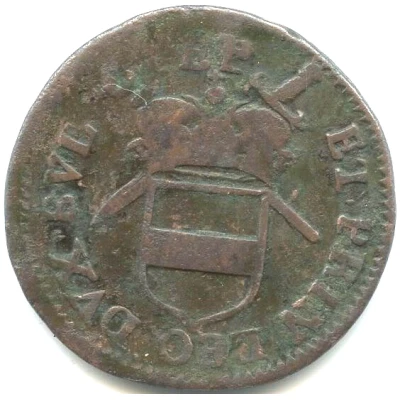Liard - Maximilian Henry of Bavaria ND
| Copper | 3.76 g | 26 mm |
| Issuer | Prince-bishopric of Liege (Belgian States) |
|---|---|
| Prince-bishop | Maximilian Henry of Bavaria (1650-1688) |
| Type | Standard circulation coin |
| Years | 1650-1688 |
| Value | 1 Liard (1⁄80) |
| Currency | Florin Brabant-Liege (1650-1795) |
| Composition | Copper |
| Weight | 3.76 g |
| Diameter | 26 mm |
| Shape | Round (irregular) |
| Orientation | Medal alignment ↑↑ |
| Demonetized | Yes |
| Updated | 2024-10-03 |
| Numista | N#65529 |
|---|---|
| Rarity index | 68% |
Reverse
Crowned, quartered arms of Bavaria-Palatinate
Script: Latin
Lettering: · EPISC · ET · PRINC · LEO : D . BVL
Unabridged legend: EPISCOPUS ET PRINCEPS LEODIENSIS DUX BULLONIENSIS
Translation: Bishop and Prince of Liege, Duke of Bouillon
Edge
Plain
Comment
KM#71 is distinguished from the more common KM#72 and KM#73 by having the Bishop's titles beginning on the side with the arms of Bouillon (shield with horizontal stripe), and using the quartered arms of Bavaria-Palatinate, rather than the simple shield of Bavaria.Interesting fact
The Maximilian Henry of Bavaria Liard coin from the Prince-bishopric of Liege (Belgian States) is interesting because it was issued during a time of great turmoil in Europe, particularly in the Holy Roman Empire, of which the Prince-bishopric of Liege was a part. The coin was minted during the reign of Maximilian Henry of Bavaria, who was the Prince-Bishop of Liege from 1650 to 1688. This was a period of political and religious upheaval, with the Thirty Years' War (1618-1648) having recently ended and the French Revolution (1789-1799) on the horizon. Despite these challenges, the coinage of the Prince-bishopric of Liege continued to be issued, with the Liard being a common denomination. The fact that this coin was made of copper, a relatively inexpensive metal, also speaks to the economic conditions of the time.



